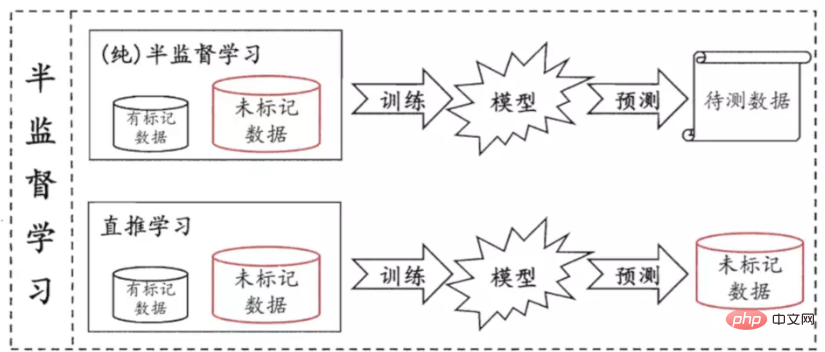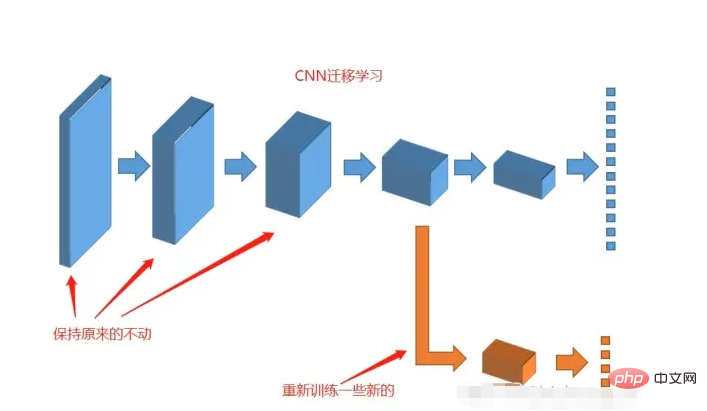
Today I will talk to you about machine learning algorithms, let’s take a look!
Machine learning algorithms mainly include supervised learning, unsupervised learning, semi-supervised learning, transfer learning, and reinforcement learning.

Supervised learning is a very common type of machine learning in machine learning, which is training when the input and output are known. Create a model and map the input to the output.
Features: Learning objectives (such as actual values, annotations, etc.) are given.
Supervised learning can be divided into classification and regression depending on whether the target result is discrete or continuous.

The prediction target value of this type is discrete. For example, predicting whether it will rain or not, there are only two final results, rain or There are two categories of situations when it is not raining.
Purpose: To predict the classification results of new samples based on historical results. The task of two classification results is called a binary task; two or more classification results are called a multi-classification task.
Common algorithms: decision tree, random forest, K-nearest neighbor algorithm, logistic regression, support vector machine, artificial neural network.
The prediction target value of this type is continuous. A typical example is to predict the price trend of a certain real estate.
Algorithms: Linear regression, AdaBoosting, etc.
The characteristic of unsupervised learning is that there is no need to label data, but continuous self-learning and consolidation based on the model, and finally learning through self-summarization. The learning model mainly includes clustering and dimensionality reduction.
Mainly refers to the process of forming a collection of physical or abstract objects into multiple categories from similar objects, which can be understood as grouping according to similar principles.
Algorithm: Common ones include K-means algorithm, BIRCH algorithm, and DBSCAN algorithm.
High-dimensional data relies heavily on system resources and algorithm performance. Dimensionality reduction is to process the unimportant information in high-dimensional data while retaining most of the important information. information. To put it simply, it is a process from complex to simple. If you make complex problems as simple as possible, it will be much less difficult to deal with them.
Advantages: Save space, save time consumed by the algorithm, and reduce the consumption of system resources.
Algorithm: Principal Component Analysis Algorithm (PCA)

The combination of supervised learning and unsupervised learning A method of learning. Semi-supervised learning uses large amounts of unlabeled data, as well as labeled data, to perform pattern recognition.
Semi-supervised learning is suitable for a small number of labeled samples and a large number of unlabeled samples, and can achieve higher accuracy predictions.

Transfer learning refers to a learning method in which a pre-trained model is reused in another learning task.
Source domain: existing knowledge; target domain: new knowledge to be learned.
RL, also known as reinforcement learning, evaluation learning, and reinforcement learning, is one of the paradigms and methodologies of machine learning.
The task of reinforcement learning is to enable smart devices to continuously learn and try like humans, and then make the most ideal solution in different environments, strengthen the process of continuous decision-making, and learn through continuous attempts. Discover which one is the best way.
Case: AlphaGo used reinforcement learning algorithm to defeat world champion Lee Sedol, Google YouTube video recommendation algorithm, etc.
The above is the detailed content of Basics of Artificial Intelligence: Introduction to Common Algorithms in Machine Learning. For more information, please follow other related articles on the PHP Chinese website!
 Page replacement algorithm
Page replacement algorithm
 Application of artificial intelligence in life
Application of artificial intelligence in life
 What is the basic concept of artificial intelligence
What is the basic concept of artificial intelligence
 mysql paging method
mysql paging method
 javac is not recognized as an internal or external command or an operable program. How to solve the problem?
javac is not recognized as an internal or external command or an operable program. How to solve the problem?
 Advantages of spring boot framework
Advantages of spring boot framework
 How to use findbugs
How to use findbugs
 Introduction to the function of converting uppercase to lowercase in Python
Introduction to the function of converting uppercase to lowercase in Python




